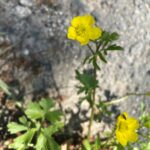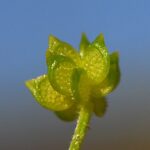Ρανούνκουλος ο κερατοειδής
Etymology of Ranunculus cornutus: "Ranunculus" in Latin means "little frog" and it is called as such by Pliny either because many Ranunculus species are aquatic or found near water, just like frogs or because many grow where frogs abound. "Millefoliatus'' is from Latin and it means "bearing a thousand leaves", from "mille" and "foliatus", a reference to the plentifulness of its foliage. "Cornutus" comes from Latin and means "horned", referring to the appearance of its fruit, which by the way, does not bear spiky parts as a horn may often imply.
The Ranunculus genus in Cyprus is rich, with at least 22 taxa (species or subspecies), a little hard to distinguish one from the other. Three of these kinds are exclusively encountered in occupied northern Cyprus.
Ranunculus cornutus in Cyprus is encountered at an altitude of up to 1375 metres. The species does not exist in non-mountainous southern Cyprus (southwestern, central-southern, southeastern). The specimen in the pictures was found at the edge of a cultivated field in Lysos (Pafos district, around 525 metres). Its flowering period is between February and May.
How to identify Ranunculus cornutus:
The flowers of R. cornutus are neither large nor small; they usually exceed 2.5 cm in diameter, and thus shouldn't be confused with arvensis, muricatus, chius, marginatus, neapolitanus, and repens which are commonly less or much less than that. More specifically, the petals can be 7-12 mm long. Ranunculus asiaticus bears huge flowers, between 2.5-7 cm in diameter (mostly around 5-6 cm).
It is an annual plant. The lower stem leaves are trisected with undissected leaflets (bearing many lobes) or dissected into three lanceolate or oblong parts (which in turn bear lobes); the upper leaves are laciniate with numerous linear-lanceolate lobes. Ranunculus creticus and constantinopolitanus bear different, huge leaves. Also, cytheraeus' leaves resemble the feet of a duck.
The peduncles are slender, longer than the subtending leaf. Its sepals are reflexed. The achenes appear with ovate-orbicular 3-4 mm discs, densely and acutely muriculate; on the contrary paludosus, millefoliatus subsp. leptaleus, isthmicus, rumelicus, kykkoensis have rather echinate achenes. Simply put, for these taxa the fruit looks like more or less the appearance of a sea urchin, whilst for cornutus, as seen in the picture, this is not the case.
Ranunculus bulbosus subsp. bulbosus appears similar but was recorded only at an elevation of 1200 metres at the Kykkos monastery's southern garden, where the lawn is located.
Finally, Ranunculus cadmicus subsp. cyprius that has some similar characteristics appears at a different altitude, of 1250–1900 metres (cornutus up to 1375 metres) and bears vivid and very dark green leaves (cornutus, open green).



